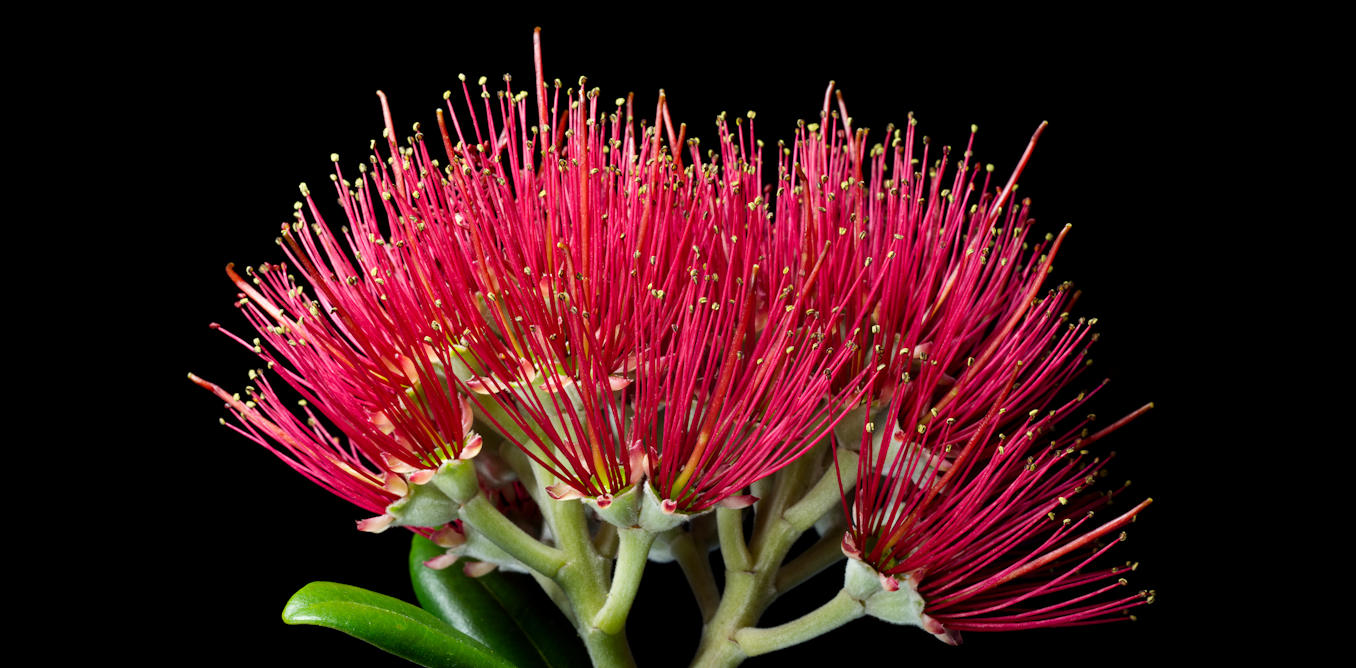On a surprisingly springlike day in late February, Shahzia Sikander was hard at work at Pace Paper Studio in the Gowanus neighborhood of Brooklyn. Having just sent off the artworks for her upcoming retrospective in Venice, she was now immersed in a new series of works on paper. She was also fielding calls about a controversy over her work that had just erupted in Texas. The dispute involved an 18-foot-high bronze sculpture recently installed in a plaza at the University of Houston. Titled Witness, the sculpture arrived there following a five-month dramafree display in Madison Square Park in New York City. Witness depicts a stylized golden woman wearing an open metal hoop skirt be-ribboned with colorful mosaics. She rises from a tangle of roots whose entwining forms are echoed in her looping arms. Her head bears a pair of elaborately coiled braids. This last detail is a version of a motif that first appeared in a painting Sikander created in 2001 and to which she has returned frequently over the years—including in her paper works at Pace that day.
In Houston, Witness drew the ire of Texas Right to Life, an anti-choice Christian group. Picking up on a description in the press of the coiled braids as horns and citing Sikander’s stated support for abortion rights, the organization called for a campus-wide protest “to keep the Satanic abortion idol out of Texas.” In response, the University scrapped a planned opening and artist talk, and decided not to present an accompanying video work by Sikander. There is no little irony in the situation. Witness exemplifies Sikander’s career-long effort to counter female invisibility in a world where images of female power are often seen as threatening and destabilizing. The calls to remove this proud symbol of female autonomy unintentionally underscored the reason Sikander had created it in the first place.

In between phone calls Sikander tried to put the controversy out of her mind as she donned rubber boots and an apron and proceeded with the painstaking work of spraying pigmented paper pulp over delicate stencils. Full figures, doubled figures, even closeups of the now-infamous coiled horns emerged kaleidoscopically in luminous layered compositions. During a break, Sikander mused on the complex symbolism behind Witness. Citing the visual history of Asia and Africa, she noted that similar images of braided hair can be found in early 20th-century Nigerian crest masks as well as in representations of the Buddha. And she pointed out that rams’ horns are a recurring motif in her sculptures, appearing also in NOW, a companion work that stands in front of the New York Appellate Division Courthouse. “The rams’ horns are universal symbols of strength and wisdom,” she remarked. “There is nothing Satanic about them.”
This kind of reductive misreading is nothing new for Sikander. At the time of the attacks on the World Trade Center in 2001 she was working on a mural for a law firm. She had been exploring a motif based on the Hindu goddess Durga, a female warrior embodying strength and courage, often represented by a woman whose multiple arms each bear a weapon. Sikander intended these as emblems of female protective power, but in the context of 9/11, the image was read as an incitement to violence. Not wanting to add to this confusion, Sikander withdrew from the commission.
Misreading extends as well to the way Sikander is perceived as an artist. In a career that spans three and a half decades, she has mastered painting, sculpture, animation, installation, and video. She works with glass, paper pulp, bronze, and mosaic. She juxtaposes imagery sourced from Indian court painting, Western Renaissance and Mannerist art, African tribal figures, Hindu and Persian legends, biblical narratives, and Western fairy tales. She melds figures drawn from the religious traditions of Buddhism, Jainism, Hinduism, Islam, and Christianity. Her works deal with a multiplicity of issues, from female power to migration, trade, colonial history, and climate change. Her originality has earned her an international reputation capped by a MacArthur “genius grant,” and her retrospective is one of the official collateral events at this summer’s Venice Biennale.
Nonetheless, Sikander finds to her frustration that she is continually described as a Pakistani artist working in the neo-miniaturist tradition. “I’ve been living and working in this country for 30 years,” she said. She maintains a studio at the Zuckerman Mind Brain Behavior Institute at Columbia University, but her project-based work allows her to move around. “My work is about wanting not to be boxed in to any stereotype, whether it’s on behalf of Pakistan or any culture or religion or non-white feminism or vision of tradition versus non-tradition. There are all these constraints. My desire is to escape imprisoning representations.”

THE UNFORTUNATE PIGEONHOLING OF Sikander’s work may have to do in part with the remarkable way she emerged as an artist. Born in Lahore in 1969, Sikander grew up in a multigenerational home, surrounded by grandparents, aunts, uncles, and siblings. She describes herself as a quiet child, constantly drawing portraits, and enthralled by her father’s knack for storytelling. “I have memories of him enacting characters,” she said. “Reading books and giving me the idea of imagination.” Despite her love of art, she initially tried to follow a more conventional path. She received a colonial high school education at Convent of Jesus and Mary and then enrolled in the Kinnaird College for Women, where she studied math and economics in what she describes as a “waiting for marriage” culture.
But these were turbulent times in Pakistan. An erosion of women’s rights followed a coup that brought a military regime to power in 1978. Like many young women, Sikander was shaken by the changes, and took an internship with the Women’s Action Forum, an organization in the forefront of resistance to the regime. The group’s founder and Sikander’s mentor there, Lala Rukh, encouraged her to enroll in the National College of Art (NCA). “In that military environment, the art school was suspect,” Sikander said. “It had historically been full of thinkers and dissent. And it was [close to] 50 [percent] … female. It was so wonderful to be able to go there.”
At the NCA, Sikander could have followed the path taken by many of her fellow students who were looking at Western models of modernist art. Instead, she chose to immerse herself in the Mughal tradition of miniature painting. It was a surprising choice: At NCA, miniature painting was considered hopelessly retrograde. The Mughal Empire had dominated South Asia from the 16th to the 18th centuries, spurring the spread of a signature art form composed of small jewel-like paintings of Mughal life and mythology. But by the 20th century, actual examples of such paintings were hard to come by in Pakistan, as the original manuscripts in which they appeared had been plundered, divided up, and sent to Western institutions. Further, works that carried on that tradition were considered tourist kitsch or dismissed as exercises in nostalgia. Even the term miniature painting was a catchall colonial construct, sweeping numerous artistic traditions under a single label. At NCA, miniature painting was seen as a dying art with little connection to the progressive agenda of an institution that was emerging as the premier art school in the country.
And that was exactly why Sikander found it interesting. She elected to work with Bashir Ahmed, a skilled miniaturist dedicated to preserving this disappearing tradition. “It was an attempt to engage with art historical visual traditions that were not the norm,” she said. “It was about looking at the pre-colonial era, looking at Safavid style, looking at Chinese history and Chinese scroll paintings, all kinds of things that were not necessarily in the books that we were studying.” Miniature painting was an outlier, and so in many ways was the teenage Sikander, a young woman driven to be an artist in a deeply patriarchal and authoritarian culture.

Sikander mixed paints from pigments, used tea stains, and learned the laborious process of painting with single-hair brushes to delineate tiny details. She spent 14 hours a day for two years completing her thesis project, imperiling her physical and mental health as she developed symptoms related to stress, prolonged sitting, and exposure to various chemicals. Although the thesis mandate was to create a series of notebook-size paintings, she employed the miniature technique to produce a single five-foot-long painting that she describes as an “epic poem.” Titled Scroll (1989–90), it unveils a panoramic view of an upperclass Pakistani home that has been opened up and spread out so that the rooms form a series of vignettes of domestic life. It is highly detailed, with a complex geometry that echoes the shifting perspectives in traditional Mughal painting. What ties it all together is the figure of a young woman in white, always seen from the back, who drifts through the house without ever actually interacting with the inhabitants as they go about their daily lives. In the very last scene, she ends up outside in the garden where she stands before an easel painting a portrait of a young woman who bears more than a passing resemblance to Sikander. The figure is a bit of a cypher, guiding us through the complicated spaces, acting in part as the viewer’s eye. “It’s not necessarily a self-portrait,” Sikander said, “but at the age of 17 or 18, what else could it be?”
Scroll created a sensation, and Sikander won national attention as well as the NCA’s highest merit award. This acclaim encouraged the school to greatly expand its miniaturist program and helped spawn what is now known as the Pakistani neo-miniaturist school of art. But Sikander herself refused to see herself simply as a neo-miniaturist. “Even from the beginning I was experimenting with the miniature,” she said. “Once I had painted it, I would disrupt it, sometimes by pouring water or putting it under the tap or thinking of ways to intentionally disrupt its preciousness.” It was a traditional form that would be a continuing reference point for Sikander’s work even as she engaged in a restless, relentless experimentation with materials, and a desire to engage with a multitude of themes.
SCROLL ANTICIPATES MANY OF Sikander’s continuing concerns: It describes a female space, it highlights class and gender disparities, it is imbued with a sense of mystery, and it presents a fluid conception of time and space. But to discover her mature language, Sikander had to leave Pakistan for the United States. The spark was the unexpected perception of herself as an Other. In 1993 she enrolled in the MFA program at the Rhode Island School of Design (RISD) in Providence. It was a moment in the American art world when multicultural differences were being simultaneously fetishized and marginalized. Sikander recalled how a professor asked, “are you here to make East meet West?”
Her frustration with this narrow conception led Sikander to experiment with radically different imagery. “Certain forms started springing out, perhaps resisting this racial straitjacket,” she said. “But they were also kind of androgynous, not necessarily fully female.” This was in part a reaction to how art from her region was depicted. “Here I am looking at these big coffee table books on Islamic art or Indian art. And in there are these shadowless representations of different native cultures. These little characters are supposedly defining what I do, or who I may be, or what my work is about. They looked like they needed to escape those pages. So I started imagining them as little monsters that are going to walk off that page. And if they were, if they had little legs, or if they were going to literally crawl off, then what would they look like?”
The answer was the beginning of a lexicon of images that recur throughout her work. There is, for instance, the headless woman whose legs have become a tangle of roots. Sikander describes her as an emblem of the erasure of the feminine from religion and history. There are the flying gopi hairpieces, small winglike objects that have become detached from the heads of the female followers of Krishna. They become agents of disintegration and re-creation as they spin off like swarms of insects or birds. There are wheels of spinning arms that expand and multiply. There are androgynous creatures, like the veiled figure who confounds gender expectations by taking on the body of a male polo player.
Sikander’s explorations were aided by her reading of feminist writers and poets like Hélène Cixous, bell hooks, and Julia Kristeva, and South Asian thinkers like Kishwar Naheed, Parveen Shakir, and Fatema Mernissi. She remarks, “I have gravitated often to the literary space, because when we think of the representation of female protagonists, we think, who gets to write the stories? How do women themselves want to be represented?”
After graduating from RISD, Sikander secured a two-year fellowship with the Glassell School of Art in Houston. Ironically, given the current controversy over Witness, she credits her time there with opening her eyes to the diversity of America and to the connections between different histories. “Houston was so different from Providence,” she said. “Houston had Arab American diaspora histories, it had the large Indonesian Vietnamese communities, and it had a large South Asian community. So there was all these multiple spaces, but they don’t necessarily come together.” She began to draw parallels between the apparently different histories of displacement and migration that characterized the American South and her native South Asia. “It was really magical,” she said. “I was thinking how it was so foreign and so familiar at the same time.”

AN INVIDATION TO THE 1997 Whitney Biennial and a show at the nonprofit Artists Space brought Sikander to New York, where she has lived ever since. In the intervening years she has created a body of work that is breathtaking in its complexity and breadth. There are jewel-like paintings like Pleasure Pillars, 2001, her first work showing rams’ horns. Here, the horned woman is quite obviously a self-portrait surrounded by female figures from various Eastern and Western traditions. In an acknowledgment of the violence of 9/11, a tiny fighter jet approaches from the distance while a winged creature shoots fire from its hands. There are works created from ink stains that bleed into translucent tracing paper to create silhouettes of headless women. There are glowing mosaics that splinter the dresses of female figures into hundreds of shards of light and color. There is a multiscreen video titled Reckoning that flashed over Times Square every night at midnight for the month of September 2023.

Intimacies, 2020.
Among Sikander’s explorations in sculpture are large public figures like Witness and its companion work, NOW, and smaller ones like Promiscuous Intimacies, which grew from a painting with the same motif. Both Intimacies and its inspiration envision the meeting of different traditions through the sensuous entwining of a truncated temple sculpture of an Indian celestial dancer and the twisting Venus of 16th-century Mannerist painter Agnolo Bronzino.
Sikander’s animations include SpiNN (2003), a critique of cable news in which an Indian ruler in a grand Mughal gathering hall is obliterated by flying gopi hair, and The Last Post (2010), which similarly disrupts the figure of a colonial-era East India company man. The monumental Parallax, created for the 2013 Sharjah Biennial, is a mesmerizing immersive panoramic video that reflects on the role of migrant labor, oil, and violence in the tortured history of the Strait of Hormuz, the narrow ocean passage between Oman and Iran.
One thing that unites these works is Sikander’s tendency to circle back, to rework previous motifs and allow them to absorb new meanings. Another is her focus on the disruption of fixed polarities like male and female, East and West, past and present, order and chaos. Collective Behavior, the retrospective currently on view in Venice, showcases all these aspects of Sikander’s work; it is organized by two Ohio-based curators: Ainsley M. Cameron, curator of South Asian art, Islamic art, and antiquities at the Cincinnati Art Museum, and Emily Liebert, curator of contemporary art at the Cleveland Museum of Art. Following its presentation in Venice, Collective Behavior will move to the curators’ respective institutions, where it will take a somewhat unconventional course. At Cincinnati, it will be fleshed out with other works, while simultaneously in Cleveland, related works will feature in dialogue with the museum’s storied South Asian collection.

Cameron has worked with Sikander on a number of projects, beginning in 2016 with the animation of an 18th-century North Indian manuscript at the Philadelphia Museum of Art. She wants the exhibition to highlight Sikander’s ability to weave together diverse histories and traditions in ways that illuminate current dilemmas. “This is a really turbulent time,” she said. “Shahzia uses art to activate so many messages and to make it the center point for the conversations that we’re having, whether it’s gender and body politics or the histories of colonial India and South Asia. She reinforces this idea that art can be a catalyst for change.”
Liebert concurs. “Her art reflects on so many of the pressing issues of our time: gender relations, migration, climate, race. But she’s always thinking about those through the lens of history,” she said, adding that “in Shahzia’s work, there’s a suggestion that the past can inform our understanding of the present.”
For Sikander, the chance to present her work in Venice offers a remarkable synergy. She points to the history of Venice as a commercial and artistic center at the nexus of global trade. “When you’re in Venice, you can see forms that are understood as Venetian, but you can often see them as well in Islamic patterning,” she said. “There is this rich history of trade between Venice and Persia or China. It’s reverberating through the Italian Renaissance painting, the illuminated manuscripts of central South Asia, and the textiles in the Islamic world. But very rarely do you see this acknowledged, even in art history.” Once again, the notion of place—who belongs where, and how people define themselves—plays a role in her work. She added with a glimmer of mirth, “I think appearing in Venice is an amusing thing for an artist like myself. There are a lot of parallels that I can recognize. I guess what I’m trying to say is, for me, it’s a perfect location.”
The post “Shahzia Sikander’s Luminous Art Explores East and West, Past and Present, Order and Chaos” by Lmiller was published on 06/10/2024 by www.artnews.com





































